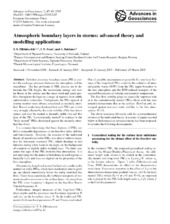| dc.description.abstract | Turbulent planetary boundary layers (PBLs) control the exchange processes between the atmosphere and the ocean/land. The key problems of PBL physics are to determine the PBL height, the momentum, energy and matter fluxes at the surface and the mean wind and scalar profiles throughout the layer in a range of regimes from stable and neutral to convective. Until present, the PBLs typical of stormy weather were always considered as neutrally stratified. Recent works have disclosed that such PBLs are in fact very strongly affected by the static stability of the free atmosphere and must be treated as factually stable (we call this type of the PBL "conventionally neutral" in contract to the "truly neutral" PBLs developed against the neutrally stratified free flow). It is common knowledge that basic features of PBLs exhibit a noticeable dependence on the free-flow static stability and baroclinicity. However, the concern of the traditional theory of neural and stable PBLs was almost without exception the barotropic nocturnal PBL, which develops at mid latitudes during a few hours in the night, on the background of a neutral or slightly stable residual layer. The latter separates this type of the PBL from the free atmosphere. It is not surprising that the nature of turbulence in such regimes is basically local and does not depend on the properties of the free atmosphere. Alternatively, long-lived neutral (in fact only conditionally neutral) or stable PBLs, which have much more time to grow up, are placed immediately below the stably stratified free flow. Under these conditions, the turbulent transports of momentum and scalars even in the surface layer - far away from the PBL outer boundary - depend on the free-flow Brunt-Väisälä frequency, N. Furthermore, integral measures of the long-lived PBLs (their depths and the resistance law functions) depend on N and also on the baroclinic shear, S. In the traditional PBL models both non-local parameters N and S were overlooked. One of possible mechanisms responsible for non-local features of the long-lived PBLs could be the radiation of internal gravity waves (IGW) from the PBL upper boundary to the free atmosphere and the IGW-induced transport of the squared fluctuations of velocity and potential temperature. The free-flow stability plays an especially important role in is the conventionally neutral PBLs (those with the zero potential-temperature flux at the surface: Fθ=0 at z=0, developed against non-zero static stability in the free atmosphere: N>0). The above reasoning obviously calls for a comprehensive revision of the traditional theory. In a series of papers (quoted below in References) an advanced theory has been proposed. It includes the following developments. | en_US |
